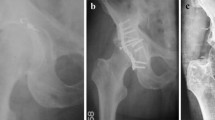Abstract
Acetabular fracture result in fairly good outcome after the anatomic reduction in the displaced fracture fragments and damaged joint structure, but some patients will inevitably suffer from hip joint problems during their courses after the insult. We retrospectively reviewed 91 patients with acetabular fractures to investigate the causes of clinical failure and relationship among the fracture types, selected treatment options and their courses. Ninety-one patients (73 men and 18 women) with an average age of 49 years (range 18–80) at the time of injury were followed up for an average of 8.6 years (range 2–18). Judet–Letournel classification of fracture type and Matta’s rating regimen of functional and radiographic patient’ assessment were conducted. Conservative treatment was provided in 20 patients, in which 19 attained excellent/good, and one fair clinical results. All achieved excellent/good radiographic outcome. Surgically treated patients (n = 71) with critical dislodgement of the fracture fragment showed that 64 (90%) attained excellent/good and 7 (10%) fair/poor clinical outcomes. Sixty-three (89%) attained excellent/good and 8 (11%) fair/poor postoperative radiographic outcome. Five patients with poor radiographic outcome after surgery subsequently required total hip arthroplasty, due to the development of hip joint osteoarthritis in 3 and femoral head avascular necrosis in 2. We conclude that displacement of the joint surface should be reduced to less than 3 mm in accordance with the selection of the most appropriate surgical approach for open reduction/fixation in each fracture type; however, comminuted fracture and avascular necrosis of the femoral head may be the cause of poor clinical results.


Similar content being viewed by others
References
Letournel E, Judet R (1993) Fractures of the acetabulum. In: Elson RA (ed) Translator editor, 2nd edn. Springer, New York, pp 18–28
Moed BR, Willson Carr SE, Watson JT (2002) Results of operative treatment of fractures of the posterior wall of the acetabulum. J Bone Jt Surg 84A:752–758
Rommens PM, Gimenez MV, Hessmann M (2001) Posterior wall fractures of the acetabulum: characteristics, management, prognosis. Acta Chir Belg 101:287–293
Giannoudis PV, Tzioupis C, Moed BR (2007) Two-level reconstruction of communicated posterior wall fractures of the acetabulum. J Bone Jt Surg 89B:503–509
Panagiotis T, Elias P, Constantinos M, Minos T, Panagiotis D, Elias L (2007) Long-term results in surgically treated acetabular fractures through the posterior approach. J Trauma 62:378–382
Helfet DL, Beck M, Gautier E, Ellis TJ, Ganz R, Bartlett CS, Siebenrock KA (2003) Surgical techniques for acetabular fractures. In: Tile M, Helfet DL, Kellam JF (eds) Fractures of the pelvis and acetabulum, 3rd edn. Lippincott Williams & Wilkins, Philadelphia, pp 533–603
Letournel E (1993) The treatment of acetabular fractures through the ilioinguinal approach. Clin Orthop 292:62–76
Letournel E (1981) Surgical fixation of displaced pelvic fractures and dislocations of the symphysis pubis (excluding acetabular fractures). Rev Chir Orthop 67:771–782
Moed BR, McMichael JC (2008) Outcomes of posterior wall fractures of the acetabulum. J Bone Jt Surg 90A(Suppl 2):87–107
Richter R, Hutson JJ, Zych G (2004) The use of spring plates in the internal fixation of acetabular fractures. J Orthop Trauma 18:179–181
Stockle U, Hoffmann R, Nittinger M, Sudkamp NP, Haas NP (2000) Screw fixation of acetabular fractures. Int Orthop 24:143–147
Letournel E (1980) Acetabulu fractures: classification and management. Clin Orthop 151:81–106
Murphy D, Kaliszer M, Rice J, McElwain JP (2003) Outcome after acetabular fracture prognostic factors and their inter-relationships. Injury 34:512–517
Kreder HJ, Rozen N, Borkhoff CM, Laflamme YG, McKee MD, Schemitsch EH, Stephen DJG (2006) Determinants of functional outcome after simple and complex acetabular fractures involving the posterior wall. J Bone Jt Surg Br 88B:776–782
Kokubo Y, Uchida K, Yokoyama O, Maegawa M, Akino H, Yayama T, Kobayashi S, Timbihurira G, Baba H (2006) Acetabular fracture causing delayed bladder laceration followed by extensive urinary leakage: an unusual case report. J Jpn Rheum Jt Surg 25:59–63 (English article)
Matta JM (2006) Operative treatment of acetabular fractures through ilioinguinal approach: a 10-year perspective. J Orthop Trauma 20(suppl):S20–S29
Uchida K, Kokubo Y, Yayama T, Nakajima H, Miyazaki T, Negoro K, Ayella RL, Kobayashi S, Sawaguchi T, Baba H (2011) Fracture of the pelvic ring: a retrospective review of 224 patients treated at a single institution. Eur J Orthop Surg Traumatol 21:251–257
Tile M, Olson SA (2003) Decision making: nonoperative and operative indications for acetabular fractures. In: Tile M, Helfet DL, Kellam JF (eds) Fractures of the pelvis and acetabulum, 3rd edn. Lippincott Williams & Wilkins, Philadelphia, pp 496–532
Sen RK, Veerappa LA (2009) Long-term outcome of conservatively managed displaced acetabular fractures. J Trauma 67:155–159
Kawahara H, Kokubo Y, Yayama T, Uchida K, Kobayashi S, Nakajima H, Oki H, Negoro K, Mwaka ES, Orwotho NT, Baba H (2010) Metaphyseal-loading anterolaterally-flared femoral stem in cementless total hip arthroplasty: five to eleven year follow-up evaluation. Artif Organs 34:377–383
Nakamura F, Fujioka M, Takahashi KA, Ueshima K, Arai Y, Imahori Y, Inani K, Nishimura T, Kubo T (2005) Evaluation of the hemodynamics of the femoral head compared with the ilium, femoral neck and femoral intertrochanteric region in healthy adults: measurement with positron emission tomography (PET). Ann Nucl Med 19:549–555
Conflict of interest
No funds were received in support of this study. No benefits in any form have been or will be received from a commercial party related directly or indirectly to the subject of this manuscript.
Author information
Authors and Affiliations
Corresponding author
Rights and permissions
About this article
Cite this article
Uchida, K., Kokubo, Y., Yayama, T. et al. Fracture of the acetabulum: a retrospective review of ninety-one patients treated at a single institution. Eur J Orthop Surg Traumatol 23, 155–163 (2013). https://doi.org/10.1007/s00590-012-0938-7
Received:
Accepted:
Published:
Issue Date:
DOI: https://doi.org/10.1007/s00590-012-0938-7




